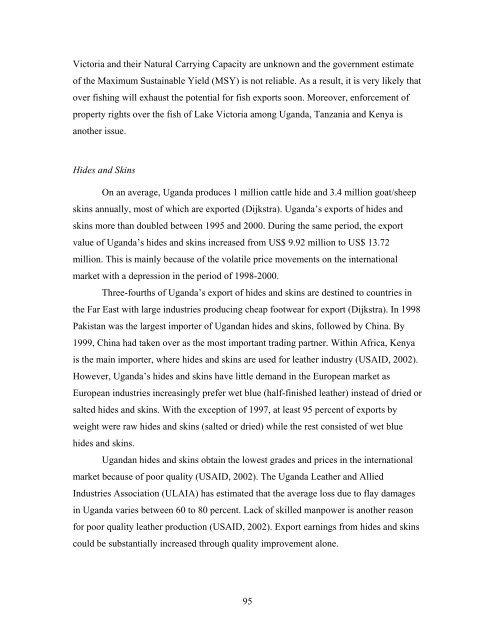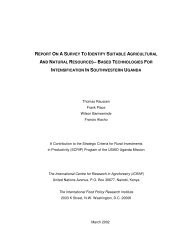Market Opportunities for African Agriculture - International Food ...
Market Opportunities for African Agriculture - International Food ...
Market Opportunities for African Agriculture - International Food ...
You also want an ePaper? Increase the reach of your titles
YUMPU automatically turns print PDFs into web optimized ePapers that Google loves.
Victoria and their Natural Carrying Capacity are unknown and the government estimate<br />
of the Maximum Sustainable Yield (MSY) is not reliable. As a result, it is very likely that<br />
over fishing will exhaust the potential <strong>for</strong> fish exports soon. Moreover, en<strong>for</strong>cement of<br />
property rights over the fish of Lake Victoria among Uganda, Tanzania and Kenya is<br />
another issue.<br />
Hides and Skins<br />
On an average, Uganda produces 1 million cattle hide and 3.4 million goat/sheep<br />
skins annually, most of which are exported (Dijkstra). Uganda’s exports of hides and<br />
skins more than doubled between 1995 and 2000. During the same period, the export<br />
value of Uganda’s hides and skins increased from US$ 9.92 million to US$ 13.72<br />
million. This is mainly because of the volatile price movements on the international<br />
market with a depression in the period of 1998-2000.<br />
Three-fourths of Uganda’s export of hides and skins are destined to countries in<br />
the Far East with large industries producing cheap footwear <strong>for</strong> export (Dijkstra). In 1998<br />
Pakistan was the largest importer of Ugandan hides and skins, followed by China. By<br />
1999, China had taken over as the most important trading partner. Within Africa, Kenya<br />
is the main importer, where hides and skins are used <strong>for</strong> leather industry (USAID, 2002).<br />
However, Uganda’s hides and skins have little demand in the European market as<br />
European industries increasingly prefer wet blue (half-finished leather) instead of dried or<br />
salted hides and skins. With the exception of 1997, at least 95 percent of exports by<br />
weight were raw hides and skins (salted or dried) while the rest consisted of wet blue<br />
hides and skins.<br />
Ugandan hides and skins obtain the lowest grades and prices in the international<br />
market because of poor quality (USAID, 2002). The Uganda Leather and Allied<br />
Industries Association (ULAIA) has estimated that the average loss due to flay damages<br />
in Uganda varies between 60 to 80 percent. Lack of skilled manpower is another reason<br />
<strong>for</strong> poor quality leather production (USAID, 2002). Export earnings from hides and skins<br />
could be substantially increased through quality improvement alone.<br />
95
















